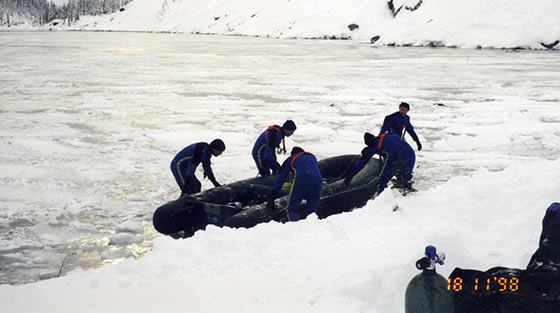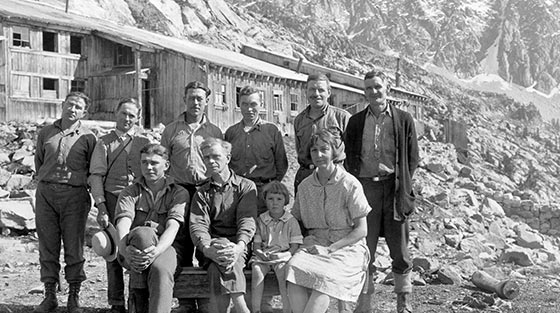The most popular hike in Kokanee Glacier Provincial Park, this is also the most heavily used trail in the entire West Kootenay. It gives access to the park core – its impressive scenery, alpine meadows and lakes delight the hiker.
Rating: ♦♦♦♦♦
Difficulty: B2
Elevation gain: 457m (1500′)
Key elevations: Gibson Lake Parking lot. 1536m (5040′); Kokanee Lake 1975m (6480′) Kaslo Lake campground 1973m (6470′); Kokanee Glacier Cabin 1960m (6430′).
Distance: 8.8km
Time: 4.5 hours one way
Season: July to early October
Access: Moderate
Map: 82F/14 Slocan, 82F/11 Kokanee Peak
Drive: Kokanee Glacier Road:
From Nelson Orange Bridge: 19.1 km (11.9 miles) east on Highway 3A.
From the Balfour Ferry: 11.7 km (7.3 miles) west on Highway 3A. Sign for Kokanee Glacier Provincial Park.
0.0 Turn north on a marked road up Kokanee Creek – a good, sometimes steep, gravel road that goes 16 km to Gibson Lake. At 2.2km, bear right; at 2.4km, bear left;
7.0km Go straight. Left is the West Fork of Kokanee Creek Trail.
11.5km Go straight. Left is the TH for the Old Growth Trail
16km Gibson Lake. Park in the spacious lot. 1536m (5040′). Review the information panels and current conditions on the porch of the picnic shelter before shouldering your pack.
Trail: A trail leads to Kokanee Lake from the parking lot. The trail used almost exclusively now is the old mining road at the northeast end of the parking lot that provides a more gradual but less attractive starting route. The original trail starts on the east edge of the parking lot and is not marked. It was originally built before 1900 for mining activities and climbs quite steeply for the first 1.6 km through a lush subalpine forest. It meets the mining road after about .8km of switchbacks. Water is available at several streams that cross the trail. After 15 minutes, turn left onto a sign-posted trail.
On the slopes above, the remains of the Molly Gibson Mine site can be seen, and gradually an ever-increasing panorama of ragged peaks unfolds. Gibson Lake can be seen below. Eventually, the terrain flattens out.
3.4km Esmeralda (Keyhole) Trail. Unmarked, it leaves the high point of the trail and ascends in a long switchback on its way to the Keyhole. Look at the post.
4.4km Kokanee Lake, the largest body of water in Kokanee Glacier PP 1975m (6480′) 1.5 hours. It is a favourite destination for day hikers, as well as for fishermen seeking the cutthroat trout that thrive in its cold water. The trail follows along its western shore, crossing a large talus slope and a more recent rock fall that required rerouting the trail through it. Hoary marmots are common here and sometimes quite tame. Do not feed!
Past the lake, the trail crosses a lush alpine meadow and climbs steadily to Kokanee Pass, then into a vast subalpine basin with many lakes and open rolling terrain. Twisted snags standing high above the scattered conifers are a reminder of a fire that swept the area in 1932.
The trail passes Keen, Garland and Kaslo Lakes 7.5kms, 1973m (6470′), as it heads steadily north, meeting the Enterprise Creek/Lemon Pass Trail just north of Kaslo Lake. Continue up the trail for your first glimpse of the Kokanee Glacier, hanging between the Battleship and Mt Kitchener, and on to the Kokanee Glacier Cabin. The trail to the old Slocan Chief Cabin goes right for 1.6km. The cabin has been restored and is now the park interpretive centre. I’m not sure if the ranger’s old A-frame is still there. The large Kalima campground below the cabin has been closed. All camping in the core area occurs at the Kaslo Lake campground, first-come-first-serve.
Enterprise Pass 2027m (6650′). View SE to Kaslo, Garland and Keen Lakes in the park’s core area. Visible beyond are Kokanee Glacier and Sawtooth Ridge.
Junction after the pass: Right goes SW ascending past Griffin Lake to Glory Basin and Sapphire Lakes. Camping is no longer allowed at Sapphire Lakes.
Straight is the main trail SE through the pass. Descends 58m (190′) in 10 minutes to a junction at the NE corner of Kaslo Lake.
Right goes to Kaslo Lake campground 1973m (6470′) (10 tent pads) then continues south past Kokanee Lake to Gibson Lake TH.
Left and NE, gains 100m (328′) in 1.4km to historic Slocan Chief Cabin, now the Parks Interpretive Centre. From there the trail goes NE to Kalima Campground (permanently closed), Helen Dean Lakes and the trail to Joker Millsite.
Left on Kaslo Lake to Kokanee Glacier Cabin 1960m 6430′: Alpine Club of Canada 403-678- 3200. 20 beds summer, mattresses, fully equipped kitchen, electricity, flush toilets, showers, gas fireplace.
KOKANEE GLACIER CABIN
The Kokanee Glacier Cabin was built as a result of campaign efforts carried out in memory of Michel Trudeau and the many other Canadians who have lost their lives enjoying Canada’s backcountry. The national Kokanee Glacier Alpine Campaign, spearheaded by BC Parks in 2000, with the support of the Friends of West Kootenay Parks and the family of former Prime Minister Pierre Trudeau surpassed its fundraising goal of $900,000. In total, $974,200 was raised.
Part of the funds were used to restore the historic Slocan Chief Cabin as a backcountry Interpretive Centre. In addition, $40,000 was donated to the Canadian Avalanche Association to help maintain the Public Avalanche Bulletin and make sure it is regularly updated.
The Alpine Club of Canada (ACC) was awarded the contract by BC Parks to operate the new cabin, as well as the Woodbury and Silver Spray cabins and the Kaslo Lake campground in Kokanee Glacier PP beginning in June 2003. The ACC will hire custodians (working from June to mid-October) and a maintenance contractor will undertake 6-8 cabin-servicing days throughout the summer.
Reservations for all three cabins are taken through the ACC’s Canmore service on the same basis as is currently in place for the ACC’s existing hut system. 9 am to 8 pm Mountain Time 403-678-3200 or info@alpineclubofcanada.ca.
Michel Trudeau Swept into Kokanee Lake. The third son of Prime Minister Pierre Trudeau (and brother of present Prime Minister Justin Trudeau) died as the result of an avalanche on November 13, 1998; at age 23. At the time, he had been working for about a year at Red Mountain Resort and living in Rossland, BC. He was taking a back-country skiing trip with some friends in Kokanee Glacier PP when he was swept into Kokanee Lake and unable to reach the shore. His companions were unable to effect a rescue, and Trudeau drowned. An extensive search was launched, but his body has never been found. The lake’s high altitude and limited days of open waters each year prevented divers from completing the search. The Trudeau family called off the recovery and later fund raised for the nearby Kokanee Glacier Cabin as a memorial to their youngest son.
When a small avalanche pushed Michel Trudeau onto the thin ice over Kokanee Lake, he broke through while still wearing skis, poles and packs. Unable to reach shore, the crystal-clear waters within the spectacular wilderness sanctuary of Kokanee Glacier Provincial Park became his gravesite.

Michel Trudeau’s tragic death brought avalanche safety into sharp focus for Canadians across the nation.
Site of the avalanche that claimed the life of Michel Trudeau, youngest son of Canada’s 15th Prime Minister, Pierre Trudeau. The avalanche originated in the cliffs on the right side of the lake near the far end in this view. Michel’s group was following the trail between the lake and the cliffs.
1998 Canadian Broadcasting Corporation (CBC) television news report on the avalanche tragedy in Kokanee Glacier Park that killed Michel Trudeau on November 15, 1998.
The Trudeau family later helped create the Canadian Avalanche Foundation, a charitable organization financially supporting public avalanche safety. © Canadian Broadcasting Corporation (CBC) Archives A.2013.17.1
The Trudeau family’s efforts to educate a snow-bound nation about the risks that skiers and snowboarders take when they cross the “stupid line”. Since Michel’s death, the Trudeau family has been a strong supporter of avalanche safety in Canada. Their message is clear: don’t cross the stupid line.

Michel Trudeau skiing
“My brother Michel was the backcountry Trudeau; he was to be a life in and of the mountains…” Justin Trudeau, 1995. We have decided as a family that this is too risky… we do not want to put any other lives at risk, and we are making a recommendation that we stand down on the recovery.” Sacha Trudeau, 1998.
Avalanche professional John Tweedy describes the difficult decision to end the search for Michel Trudeau due to dangerous conditions. Michel Trudeau, the youngest son of former Prime Minister, P. E. Trudeau, was killed in an avalanche in Kokanee Glacier Park in 1998. At the time of the accident, Tweedy worked as an avalanche professional in charge of highway safety on Highway 3 through Kootenay Pass, BC.

Police dive team search Kokanee Lake for Michel Trudeau several days after the accident, in 1998.

An avalanche killed 9 people at the Molly Gibson Mine above Kokanee Lake on December 25, 1902.
22 people have died in avalanches in the vicinity of Kokanee Lake between 1902-2011. They include 13 backcountry skiers and 9 miners at the Molly Gibson Mine above Kokanee Lake.
